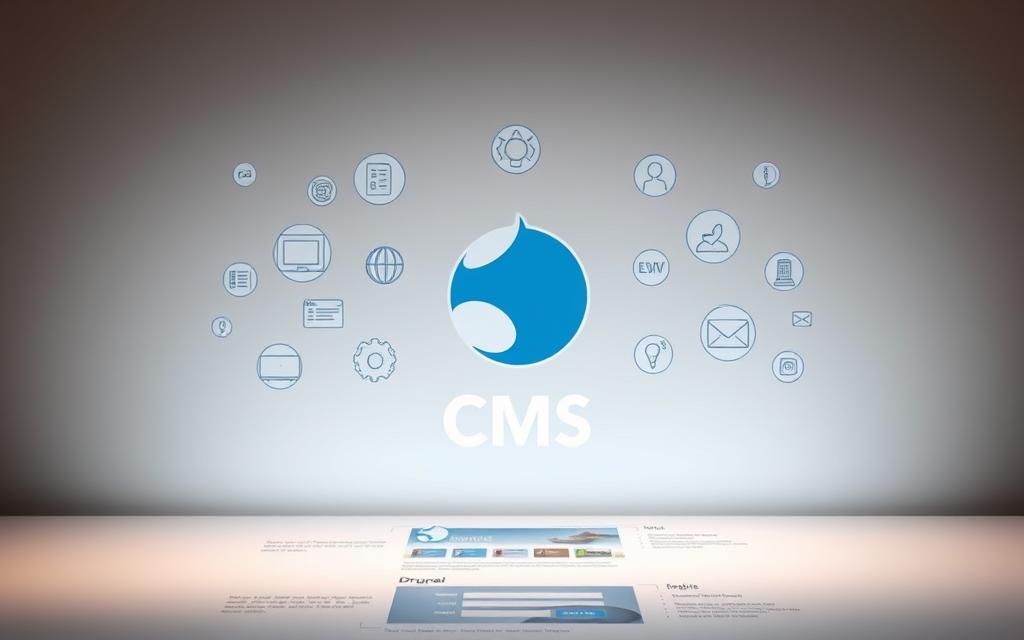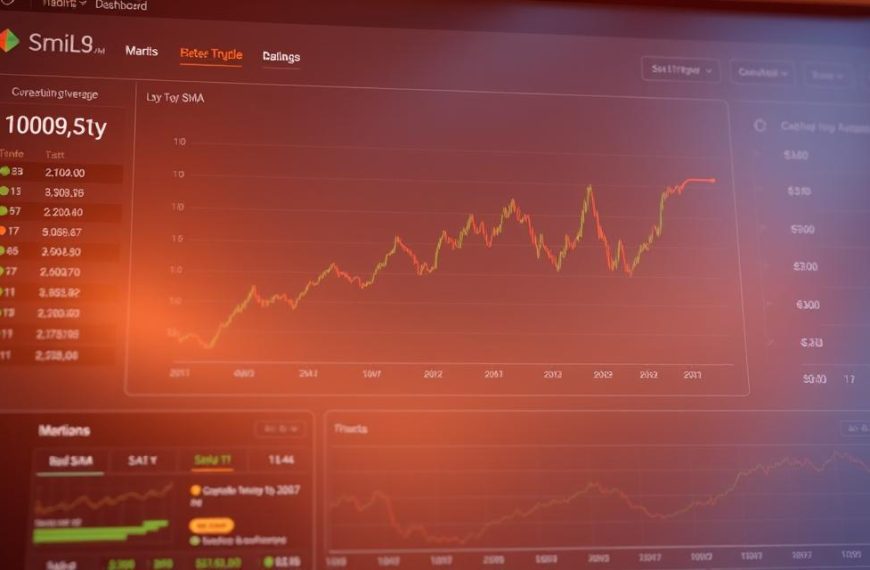Drupal shines as a robust content management system in the digital world. It’s an open-source platform that delivers flexible solutions for various digital challenges. Drupal empowers organisations to create sophisticated web experiences.
Since 2001, Drupal has transformed web development. It’s now a critical tool for many leading organisations. Half of Fortune 500 companies use Drupal, showcasing its enterprise-grade capabilities1.
Over 783,930 websites use Drupal’s infrastructure. This proves its versatility in meeting complex web development needs. Drupal’s strength comes from its vibrant community and extensive ecosystem1.
In 2023, more than 7,800 professionals contributed to Drupal’s development. This ensures continuous innovation and improvement. The platform offers over 51,000 modules for extended functionality1.
Drupal powers websites across educational institutions and government agencies worldwide. It’s used by 71% of top universities, including MIT and Oxford. The platform also serves agencies in over 150 countries1.
Drupal 10, released in December 2022, offers enhanced features for modern web development. Its core capabilities include sophisticated content management tools and advanced user permission systems1.
Understanding the Core of Drupal CMS
Drupal is a powerful open-source CMS that revolutionises web development. It offers robust PHP framework and comprehensive content management capabilities2. The platform has become crucial for organisations seeking flexible and scalable digital solutions3.
Drupal’s sophisticated PHP-based architecture allows developers to create complex websites easily. The CMS keeps evolving, meeting the needs of both technical and non-technical users4.
Open-Source Development Platform
Drupal, an open-source CMS, offers unique advantages for web developers and organisations:
- Community-driven innovation
- Continuous improvement
- Extensive module ecosystem
The platform powers an impressive 12.8% of top 10,000 websites. This statistic showcases Drupal’s robust capabilities3.
PHP-Based Architecture
Drupal’s PHP framework provides exceptional flexibility and performance. Its architecture supports:
- Rapid website development
- Scalable content management
- Secure web applications
Content Management Capabilities
Drupal excels in content management, offering sophisticated tools for digital content. It provides over 40,000 free modules3. These modules allow organisations to customise their digital experiences precisely.
Drupal transforms complex web development into an accessible and powerful process.
What is Drupal Technology?
Drupal is a potent open-source content management system (CMS). It has revolutionised digital content management. This platform offers robust CMS features for crafting complex websites across various sectors5.
Drupal excels as a versatile web development tool. It can handle intricate digital projects with remarkable adaptability.
The core strengths of Drupal’s technology include:
- Modular architecture enabling extensive customisation
- Advanced content management capabilities
- Scalable platform for diverse digital experiences
Drupal’s ecosystem is vast and impressive. It boasts over 50,000 free modules to enhance its functionality5. Developers can use more than 3,000 free themes to customise website designs5.
This wealth of resources allows businesses to create unique digital solutions. They can tailor these solutions to their specific needs.
Drupal’s global impact is significant. It powers at least 14% of the top 10,000 websites worldwide5. The platform has a huge community of 1.39 million members.
It also has 124,000 active contributors5. This reflects Drupal’s collaborative and innovative approach to web development.
Drupal technology continues to evolve, offering sophisticated CMS functionality that meets the dynamic needs of modern digital platforms.
Essential Features and Components
Drupal offers robust features for seamless web development and content management6. Its modular architecture enables extensive customisation, providing powerful tools for unique digital experiences6. Content editing and theme customisation are key strengths for web professionals.
Let’s explore the critical components that make this content management system so versatile. These features enhance website functionality and user experience.
Layout Builder and Editing Capabilities
The Layout Builder is a game-changing feature for content creators. Users can design sophisticated page layouts with drag-and-drop functionality6. The WYSIWYG editor provides an intuitive interface for crafting and styling content.
Module System Overview
Drupal modules extend the platform’s functionality dramatically. These plug-and-play components allow quick addition of specific features to websites6.
Key module capabilities include:
- E-commerce integration
- Social media connectivity
- SEO optimization tools
- Advanced content management
Theme Management
Theme customisation in Drupal goes beyond basic templates. The platform supports intricate design modifications for unique digital experiences6. Developers can build bespoke themes or modify existing ones to match branding requirements.
| Drupal Feature | Customisation Level |
|---|---|
| Layout Builder | High |
| Module Extensions | Extensive |
| Theme Flexibility | Unlimited |
Drupal’s comprehensive suite of content editing tools empowers organisations. They can create dynamic, responsive websites tailored to their exact specifications6.
Security and Performance Optimisation
Drupal’s security is crucial for web developers seeking robust protection. The platform’s team constantly identifies and mitigates potential vulnerabilities. They develop advanced measures to address evolving cybersecurity challenges7.
Drupal’s website performance optimisation involves several strategic techniques:
- Implementing intelligent caching mechanisms7
- Utilising content delivery networks (CDNs)7
- Optimising image assets through compression7
- Minifying CSS and JavaScript files7
These strategies can dramatically improve website responsiveness. Optimised themes like Zen or Omega can significantly influence site speed7.
Varnish Cache enables remarkable performance improvements. It caches complete HTML outputs in memory, boosting overall site efficiency7.
| Optimisation Technique | Performance Impact |
|---|---|
| Intelligent Caching | Reduces server load |
| CDN Distribution | Minimises latency |
| Image Compression | Reduces webpage size |
Drupal’s commitment to security and performance ensures websites remain both protected and highly efficient.
Content Management and Publishing Workflows
Drupal’s sophisticated content workflow system empowers organisations to manage digital content precisely. It provides robust tools for creating, reviewing, and distributing content across various platforms8.
Drupal excels in providing granular permission management for modern digital content needs. Organisations can create custom workflows tailored to their specific requirements9.
Content Creation and Management
The content workflow in Drupal supports multiple stages of content development, including:
- Draft creation
- Technical review
- Collaborative editing
- Final approval
- Publication
User Permission Management
Drupal’s user roles system enables organisations to define precise access levels. Team members can be assigned specific permissions, ensuring content integrity and controlled access10.
Effective content management is about controlling who can do what, when, and how.
Publishing Controls
The publishing system offers advanced features like:
- Automated content transitions
- Parallel workflow support
- State-based content moderation
- Automated notifications
These powerful content workflow tools help organisations streamline their digital content processes. They reduce errors and maintain high-quality standards in content management9.
Drupal’s Enterprise-Level Capabilities

Drupal shines as a robust enterprise CMS, offering exceptional scalability for large organisations. Its architecture allows businesses to manage complex web ecosystems with ease. The platform’s multisite management centralises control whilst maintaining flexibility for individual sites.
Key enterprise-level features include:
- Seamless integration with existing enterprise systems11
- Advanced content management workflows11
- Granular permission controls for secure access11
Drupal’s enterprise solution supports organisations across various sectors. Major brands like NASA, The Economist, and Tesla rely on its capabilities. The platform manages multiple websites from a single installation, simplifying digital strategies.
Drupal excels in supporting high-traffic loads and managing large content volumes. With over 50,000 potential integrations, businesses can craft bespoke digital experiences. This flexibility allows for highly customised solutions tailored to specific needs.
Remarkably, 1 in 8 enterprise websites globally run on Drupal. This widespread adoption showcases its reliability in critical digital environments.
Integration and API Functionality
Drupal’s robust API integration capabilities empower developers to create powerful web applications. Its sophisticated architecture supports comprehensive API functionality, transforming digital experiences.
Drupal enables developers to build and consume RESTful APIs, enhancing web application flexibility12. The platform offers multiple integration strategies to support diverse technological ecosystems.
REST API Support
Drupal’s REST API capabilities allow developers to create sophisticated web services effortlessly. They can access external data sources with ease.
- Weather updates
- Social media feeds
- Real-time information streams12
Third-Party Integrations
Drupal’s integration framework connects with various external services, expanding site functionality significantly13. Key integration areas include:
- E-commerce payment gateways
- Social media platforms
- Geolocation services
Database Management
Drupal offers exceptional database compatibility, supporting multiple systems for efficient data management14. Its Entity API simplifies content type management, making it ideal for complex digital projects.
These integration capabilities allow organisations to create dynamic, interconnected digital experiences. Such experiences can adapt to ever-changing technological landscapes.
Customisation and Extensibility
Drupal excels in web development with its impressive flexibility15. Its modular design allows developers to craft websites that match specific needs15. With over 48,000 modules, Drupal offers vast opportunities for expansion16.
Drupal’s theming system is key to its customisation power. Developers can completely change website looks through advanced theming methods. Drupal 10’s Olivero theme boosts user experiences and customisation options16.
- Extensive module library for enhanced functionality
- Advanced theming capabilities
- Flexible content management
- Seamless integration options
Drupal’s customisation potential is impressive but needs technical know-how. Skilled developers can create bespoke solutions for complex organisational needs15. The platform’s design allows websites to adapt to changing business needs16.
Drupal empowers developers to create truly unique digital experiences through its unparalleled customisation framework.
Drupal’s customisation approach appeals to enterprises seeking scalable web solutions. The global developer community constantly expands the platform’s abilities15. This ensures ongoing innovation in modules and theming strategies16.
Multisite Management and Scalability
Drupal’s robust multisite platform revolutionises web management for organisations. It allows businesses to oversee multiple websites from one installation1718. This approach cuts down resource complexities and boosts website scalability19.
Web teams can use Drupal’s multisite features to handle diverse digital ecosystems efficiently. Universities, government bodies, and companies can build independent sites within a unified framework18. Each site keeps unique settings while sharing core resources19.
Resource optimisation is a key benefit of Drupal’s multisite structure. Running multiple sites from one codebase slashes hosting costs and server needs19. Simultaneous updates and centralised maintenance boost operational efficiency1819.
Drupal’s modular design makes performance scaling effortless. It supports database clustering, advanced caching, and cloud hosting for high-traffic demands17. Admins use a single control panel for easy site management and quick system-wide changes19.
FAQ
What is Drupal and how does it differ from other content management systems?
Is Drupal suitable for enterprise-level applications?
How secure is Drupal compared to other web platforms?
Can Drupal handle complex content management workflows?
What programming language is Drupal based on?
How extensible is Drupal?
Does Drupal support API integrations?
Can Drupal manage multiple websites from a single installation?
What type of websites can be built with Drupal?
How does Drupal support content creation?
Source Links
- https://evolvingweb.com/blog/what-is-drupal
- https://www.lullabot.com/resource/drupal
- https://www.drupalpartners.com/blog/what-future-scope-drupal-cms-technology-2023-and-beyond
- https://dev.acquia.com/blog/drupal-cms-new-way-drupal
- https://en.wikipedia.org/wiki/Drupal
- https://www.theknowledgeacademy.com/blog/drupal-features/
- https://gole.ms/blog/security-and-speed-optimization-drupal-11
- https://evolvingweb.com/blog/implementing-content-publication-workflows-drupal
- https://www.newtarget.com/web-insights-blog/drupal-10/
- https://www.axelerant.com/blog/drupal-10-content-management-workflows-moderation
- https://optasy.com/blog/everything-you-should-know-about-drupal-enterprise
- https://svinfotech.net/blog/api-integration-drupal-connecting-external-services
- https://makers365.com/blog/power-external-api-integration-drupal
- https://www.monarq.ca/blog/comparing-drupal-other-platforms-api-contrib-and-core-modules
- https://www.theknowledgeacademy.com/blog/what-is-drupal/
- https://tmotions.com/discover-power-drupal-10-unveiling-key-insights-must-know-secrets/
- https://www.newtarget.com/web-insights-blog/scalable-drupal-website/
- https://meant4.com/blog/drupal-multisite-website/
- https://cmsminds.com/blog/drupal-multisite/











